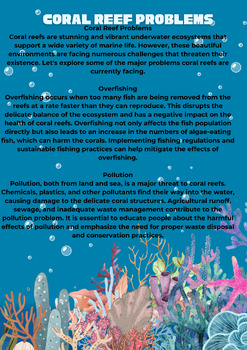Coral Reef PBL
Stand Out Science and Social Studies
1 Follower
Grade Levels
4th - 8th
Subjects
Resource Type
Standards
NGSSMS-ESS3-4
NGSSMS-ESS3-3
Formats Included
- Google Drive™ folder
Stand Out Science and Social Studies
1 Follower

Made for Google Drive™
This resource can be used by students on Google Drive or Google Classroom. To access this resource, you’ll need to allow TPT to add it to your Google Drive. See our FAQ and Privacy Policy for more information.
Description
Students will learn about symbiotic relationships, coral reefs, and problems facing coral reefs. There are reading comprehension texts and questions that can be answered. Then the will be asked to research 10 animals and create a diorama of a coral reef with facts included. Comprehension learning, and science circle discussions, google form graded assignment, quizlet study sets, Edpuzzle video and question and rubric for final project included. Great resource for Earth Day! Complete package here!
Total Pages
Answer Key
Included
Teaching Duration
1 Week
Report this resource to TPT
Reported resources will be reviewed by our team. Report this resource to let us know if this resource violates TPT’s content guidelines.
Standards
to see state-specific standards (only available in the US).
NGSSMS-ESS3-4
Construct an argument supported by evidence for how increases in human population and per-capita consumption of natural resources impact Earth’s systems. Examples of evidence include grade-appropriate databases on human populations and the rates of consumption of food and natural resources (such as freshwater, mineral, and energy). Examples of impacts can include changes to the appearance, composition, and structure of Earth’s systems as well as the rates at which they change. The consequences of increases in human populations and consumption of natural resources are described by science, but science does not make the decisions for the actions society takes.
NGSSMS-ESS3-3
Apply scientific principles to design a method for monitoring and minimizing a human impact on the environment. Examples of the design process include examining human environmental impacts, assessing the kinds of solutions that are feasible, and designing and evaluating solutions that could reduce that impact. Examples of human impacts can include water usage (such as the withdrawal of water from streams and aquifers or the construction of dams and levees), land usage (such as urban development, agriculture, or the removal of wetlands), and pollution (such as of the air, water, or land).


